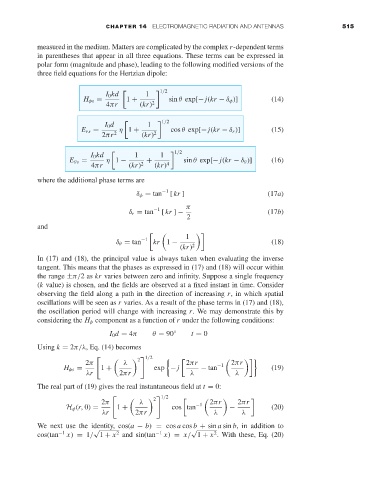Page 533 - Engineering Electromagnetics, 8th Edition
P. 533
CHAPTER 14 ELECTROMAGNETIC RADIATION AND ANTENNAS 515
measured in the medium. Matters are complicated by the complex r-dependent terms
in parentheses that appear in all three equations. These terms can be expressed in
polar form (magnitude and phase), leading to the following modified versions of the
three field equations for the Hertzian dipole:
I 0 kd 1 1/2
H φs = 1 + sin θ exp[− j(kr − δ φ )] (14)
4πr (kr) 2
I 0 d 1 1/2
E rs = η 1 + cos θ exp[− j(kr − δ r )] (15)
2πr 2 (kr) 2
I 0 kd 1 1 1/2
E θs = η 1 − + sin θ exp[− j(kr − δ θ )] (16)
4πr (kr) 2 (kr) 4
where the additional phase terms are
δ φ = tan −1 [ kr ] (17a)
δ r = tan −1 [ kr ] − π (17b)
2
and
1
δ θ = tan −1 kr 1 − (18)
(kr) 2
In (17) and (18), the principal value is always taken when evaluating the inverse
tangent. This means that the phases as expressed in (17) and (18) will occur within
the range ±π/2as kr varies between zero and infinity. Suppose a single frequency
(k value) is chosen, and the fields are observed at a fixed instant in time. Consider
observing the field along a path in the direction of increasing r,in which spatial
oscillations will be seen as r varies. As a result of the phase terms in (17) and (18),
the oscillation period will change with increasing r.We may demonstrate this by
considering the H φ component as a function of r under the following conditions:
I 0 d = 4π θ = 90 ◦ t = 0
Using k = 2π/λ, Eq. (14) becomes
2 1/2
2π λ 2πr −1 2πr
H φs = 1 + exp − j − tan (19)
λr 2πr λ λ
The real part of (19) gives the real instantaneous field at t = 0:
1/2
2
2π λ −1 2πr 2πr
H φ (r, 0) = 1 + cos tan − (20)
λr 2πr λ λ
We next use the identity, cos(a − b) = cos a cos b + sin a sin b,in addition to
√
√
2
cos(tan −1 x) = 1/ 1 + x and sin(tan −1 x) = x/ 1 + x .With these, Eq. (20)
2

